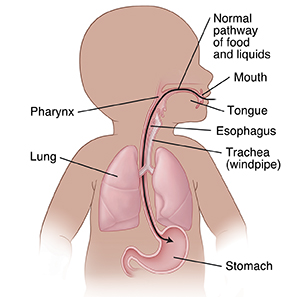When Your Child Has Dysphagia
Dysphagia is a condition in which your child has problems swallowing food or liquids. It often affects children who are just learning to eat solid foods. Dysphagia can make it hard for your child to get enough nutrients for normal growth and development.
Normal swallowing
Food enters the mouth and is chewed. The tongue moves the chewed food to the back of the throat (pharynx). The food is then swallowed. It passes into the esophagus. The esophagus is the muscular tube leading to the stomach. The esophagus tightens and relaxes in wavelike motions to move swallowed food into the stomach.
 |
| During normal swallowing, food and liquids move from the mouth, through the throat, down the esophagus, and into the stomach. |
What are the symptoms of dysphagia?
Common symptoms of dysphagia include:
-
Choking, coughing, or sputtering while eating or drinking
-
Poor sucking reflex
-
Fussiness or arching of the back
-
Drooling
-
Noisy breathing
-
Not gaining weight
-
Trouble chewing and swallowing, refusing food, or taking a very long time to eat
-
Upper respiratory problems, such as pneumonia, from food or drink being breathed into the lungs (aspirated)
-
Occasional vomiting, or having stomach contents and digestive acids flow back into the throat (regurgitation)
What causes dysphagia?
Dysphagia can be caused by any of the following:
-
Nerve or brain problems that affect control of muscles in the mouth, tongue, throat, or stomach
-
Other health problems that exist at the same time. These include prematurity, GI (gastrointestinal) disorders, and congenital heart disease.
-
Problems with the shape of a child’s mouth, tongue, or throat
-
Thickening or narrowing of the esophagus (stricture)
-
Structural problems such as cleft lip or palate
How is dysphagia diagnosed?
To find out if your child has dysphagia, the healthcare provider may order some tests. One such test might be a swallow study. This test can help the provider learn more about your child's swallowing problem. The swallow test lets the provider watch your child swallow a barium solution while this action is X-rayed. Sometimes endoscopy is used to see your child's esophagus.
How is dysphagia treated?
Your child’s treatment will depend on where the problem is located and what is causing the problem. Treatment may include:
-
Therapy to help your child learn how to move food correctly in the mouth
-
Therapy to help develop swallowing skills
-
Medicine prescribed if reflux is a problem
-
Insertion of a feeding tube in the nose or stomach. This may be done if the problem is severe and your child needs help getting nutrition.
-
Changes in diet such as thickened foods that help your child chew more easily
-
A procedure to widen the esophagus if the esophagus is too narrow
Call 911
Call 911 if food seems to get stuck in your child's mouth or throat during feeding and:
-
Your child has trouble breathing, or breathing stops during feeding, or
-
Your child’s skin or lips turn blue when feeding
Online Medical Reviewer:
Jen Lehrer MD
Online Medical Reviewer:
L Renee Watson MSN RN
Online Medical Reviewer:
Rita Sather RN
Date Last Reviewed:
5/1/2022
© 2000-2024 The StayWell Company, LLC. All rights reserved. This information is not intended as a substitute for professional medical care. Always follow your healthcare professional's instructions.